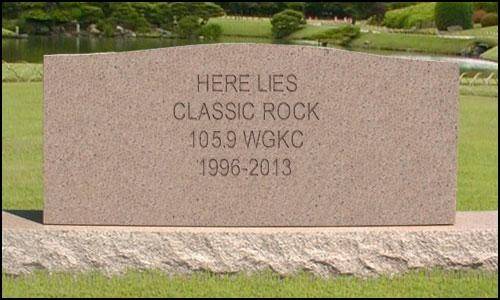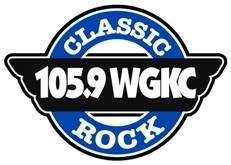
News arrived last Monday, January 14 of another Champaign radio station being blown to bits — Classic Rock 105.9 WGKC was detonated, replaced by Country 105.9. WGKC had been one of the longest-serving music formats in the area, broadcasting classic rock from November 15, 1996 to January 14, 2013. The format had thrived (for the most part) under, and often in spite of, three different ownership groups.
(Full Disclosure: The author worked in central Illinois radio for eleven+ years, including six of those at some of the stations mentioned in this article.)
Champaign-Urbana’s radio landscape is, and has been, so lacking in variety for such a long time (even compared to smaller markets), that the decision to switch to an existing (and well-established) format is baffling to say the least. So too is the overall lack of individual station identities and programming that could be competitive with satellite radio or other outlets. (One would have to guess that the only reason satellite radio isn’t more of a threat to Chambana’s terrestrial stations is because commute times around town average roughly 10–20 minutes maximum, making the monthly subscription fee either excessive or unjustifiable for some residents.)
 Two additional factors not to be overlooked:
Two additional factors not to be overlooked:
- The radio group that owns 105.9 WGKC has tried the country format twice within the last 10 years. It has not succeeded well enough either time to become established.
- WIXY 100.3, the area’s main country station, has a transmitter that provides 13,000 watts of daytime power, and thus a significantly stronger signal and wider coverage range (as compared to WGKC’s 2,500-watt transmitter).
All that being said, what are the alternatives? What would introduce some diversity into the market and provide a product that might resonate with listeners and advertisers?
I’m glad you (I) asked. Below are ten other choices for the sparse Champaign-Urbana radio landscape that would have been better not only for listeners, but for businesses as well. They are not ranked in any particular order of importance or priority. Obviously, some may be stronger choices than others; nonetheless, each of the following could be effective in the market and meet the needs of everyone concerned much better than duplicating an existing format.
Let’s take a look at some of the other ways that Chambana’s airwaves could be put to use.
Classic Hits – A case could be made (convincingly or otherwise) for changing/modifying the format because other so-called rock stations in town were leeching listeners away. Debatable? Perhaps, but it is as good a reason as any to at least consider a switch.
The mildest shift away from classic rock also affords a fair level of audience retention — Classic Hits. Designed as a format to bridge the gap between some of the later “oldies” tracks and the lighter side of classic rock, classic hits programming would forgo heavier rock tracks in favor of a wider variety of tracks from the late sixties through the early- or mid-eighties. Additionally, the format is designed to attract baby boomers, of which there are over 42,000 in the Champaign County area (according to 2010 data).
With a fair percentage of the existing music library being retained and then expanded for broader appeal, this format would have been a justifiable and, perhaps, bankable choice.
Jack or Bob FM – Similar to the above format but broader, the Jack FM or Bob FM (on-air brands of roughly the same format) station plays a range of songs from the sixties (or fifties, in some cases) up to and through the nineties, and may even include some current songs.
In central Illinois, 92.5 The Chief is the closest representative of the Jack format, though significantly more limited than the potential breadth the format would imply. In spite of 92.5 The Chief’s presence in the market, a similar but wider-reaching format with a significantly larger library of songs could realistically develop and grow a large audience.
“Vintage Vinyl” – While turntables are unlikely to take up residence in radio studios again, the concept of the Vintage Vinyl format is not about the media as much as the experience. The music mentioned in the above two formats would all be fair game, certainly, but so too would nearly any other track from that era. Album tracks, b-sides, “deep cuts,” you name it — this type of format opens the floodgates of what could be played on the station and steps away from the too-restrictive standard format conventions (typically 300–350 songs in the library, total).
This would also coincide nicely with the resurgence in both new and used record sales on vinyl, and also an audience that is young but devoted to the idea of “records” and the experience of active listening.
Album-Oriented Rock – Album-oriented rock, or AOR, was one of the first formats for FM music radio, as playlists and libraries were beginning to be more tightly controlled in the interest of building and retaining certain audiences. However, unlike the excessively confined (and resultantly repetitive) playlists on most modern formats, AOR afforded DJs a significant level of freedom to play nearly any track from an album. Thus, a similarity to the “Vintage Vinyl” concept listed above, if somewhat narrower in scope.
Adult Album Alternative (AAA) – Spinning off from AOR, the Adult Album Alternative format differentiates itself from some of the aforementioned styles by being less restrictive of the musical styles it plays — essentially any type of music with a broad adult appeal could or would be fitting, including indie rock, alternative, alt country, blues, adult contemporary, folk, etc. The range of artists, then, would be equally broad, including music that is underrepresented by traditional formats. The best regional example is Chicago’s 93 XRT, which has operated as this type of station either in part or in full since 1976.
It is worth taking a moment to throw an “Honorable Mention” to Farmer City’s 98.3 The Whip, which is, for the most part, the only station representing some of these formats in the area.
Classic Soul/R&B – While elements of the above formats may be present in Champaign radio (though barely), this one is completely absent. Classic Soul/R&B, as the name would imply, plays a range from “urban oldies” to “new school R&B” (New Edition, Boyz II Men, Tony! Toni! Tone!, etc.). The format is branded in some markets as “Old School hits,” with examples including Burbank, CA’s Hot 92.3, Mega 104.3 in Scottsdale, AZ, and Colorado’s Jammin’ 101.5.
A focused Classic soul/R&B station would have a broad appeal across multiple demographics, and would offer a music library that is severely underrepresented in Champaign. (And would be fun to listen to as well.)
Adult Contemporary R&B – A subsection of the familiar adult contemporary format, adult contemporary R&B would build a library of songs on the softer, more soulful side of current R&B – think more Anthony Hamilton and Alicia Keys, less Pitbull and Black Eyed Peas.
Soft R&B, smooth jams, love songs — whatever you might call it — this is another format with some viability in the Champaign market, and with a broader potential appeal than stations that aim/skew toward a younger audience (Q96 and Hot 105.5).
Jazz/Blues mix or Smooth Jazz – With the exception of scheduled programming on community radio station WEFT 90.1, there is little, if any, broadcast representation for jazz and/or blues music in Champaign-Urbana. Likewise, there is no smooth jazz format station catering to that listening audience either. One of these options, or some combination of them, would have been a more appropriate and serviceable choice than adding another country station to the limited and crowded airwaves in central Illinois.
Soft AC/Easy Listening/Adult Standards – This three-in-one heading allows for a lot of flexibility, but the basics are the same: the softer side of music, including singer/songwriter, acoustic, ballads, love songs, solo vocalists, etc. Satellite stations such as Sirius XM’s The Coffee House would be an example.
One could argue that Lite Rock 97.5 already represents this format locally, so it may not be the strongest option among those listed. However, the counterpoint could be made that Lite Rock’s playlist is lacking in one or more of these categories of music, which would open the door for creating a station that filled those gaps.
Classic Alternative – Yes, Classic Alternative. You may remember (or not) that this format was already tried here in Chambana, and in the same building no less. But don’t be so quick to dismiss the idea based on the failure of that experiment. Properly executed and tailored to Champaign-Urbana’s slightly younger audience, the format could have developed a loyal following.
(Sidenote: don’t buy any mention in the above link of Mr. Binder “creating” the classic alternative format, as this article and this one point out the growth of the format in certain markets back in 2004.)
One of the major shortcomings of that ill-fated initial attempt at Classic Alternative was the fact that it was operated in exactly the opposite way from what many listeners might have hoped or expected. Rather than a wide scope of music ranging from the mid-seventies to the late-nineties (and encompassing/tracing various threads of what would eventually become alternative music), 93.5 The Source was more narrowly defined even than the format that preceded it (active rock). It seems antithetical to launch a classic alternative station in a town full of college students, grad students, and young professionals that didn’t include this song, or this one, or this one. These factors, in addition to an anemic library of just a couple hundred songs in the era of the iPod, made for a short shelf life.
Executed more purposefully, a classic alternative could serve to bridge the gap between listeners still a little too young for classic rock and a little too old for candy pop or pop country or the mediocrity that is current modern rock (Gens X and Y, for instance).
—
With the ten potential format options listed here, and with the fact that this radio group’s attempts at country have twice been unsuccessful, why choose this particular format? Playing the same 200–300 songs that are already being played by another station in the area will do nothing to bring back those listeners who have already deserted this parched radio landscape, nor will it provide an impactful venue for local advertisers. It’s essentially cutting an already small pie into even smaller pieces.
So, which of the above formats would you rather listen to? Which do you wish someone would offer to breathe a bit of life into Chambana’s airwaves? Or, if none of the above quite fit the bill, what other formats would you suggest?








